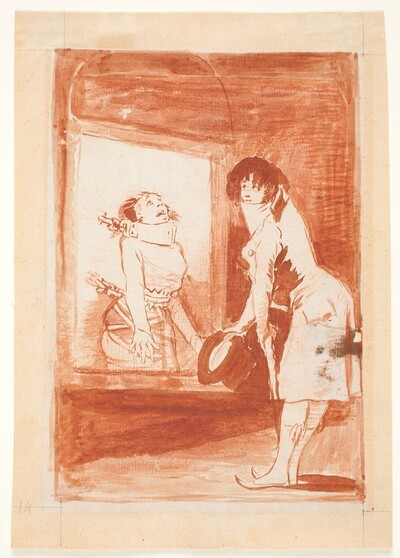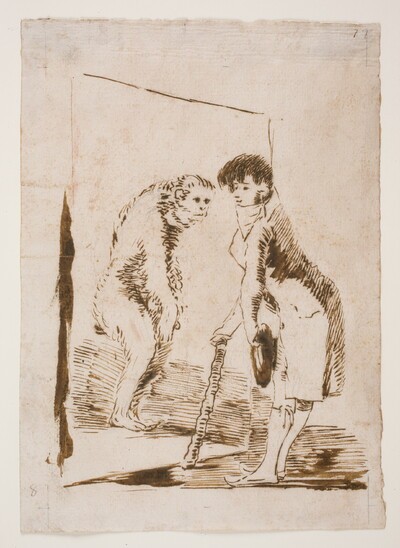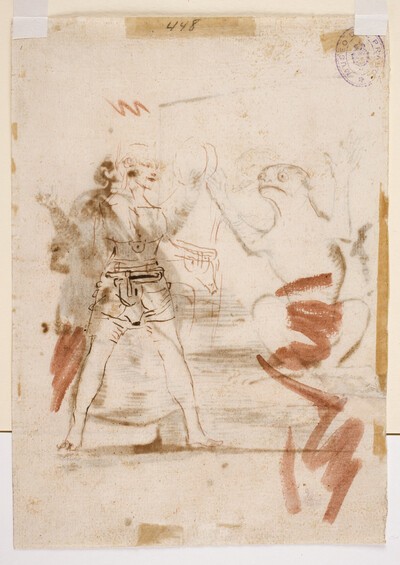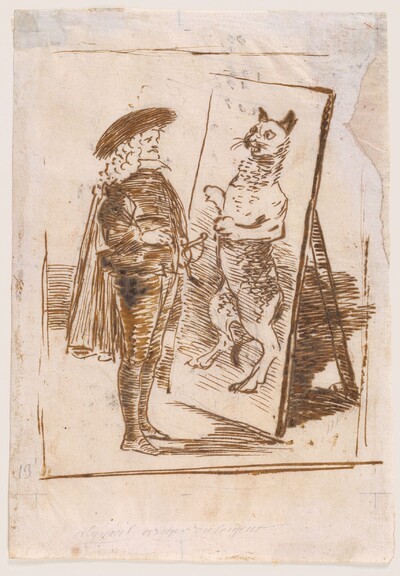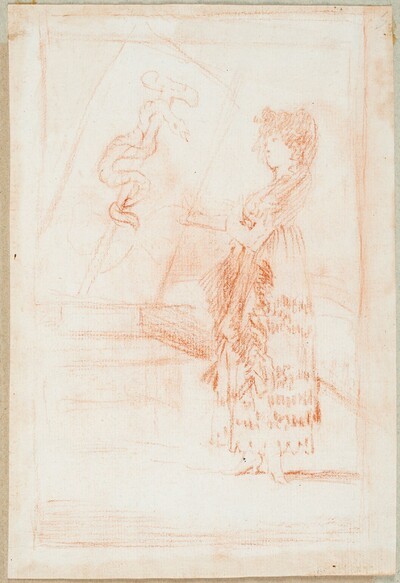- Cronología
- 1797 - 1798
- Ubicación
- The Prado National Museum. Madrid, Madrid, Spain
- Dimensiones
- 207 x 147 mm
- Técnica y soporte
- Reconocimiento de la autoría de Goya
- Documented work
- Titular
- El Prado National Museum
- Ficha: realización/revisión
- 20 Aug 2021 / 08 Jun 2023
- Inventario
- D4362r
3 (black pencil, upper left)
20 (black pencil, lower left)
Watermark: Guarro, letters "GVA [tower] RRO" (lower half)
By inheritance it passed in 1828 to Javier Goya, the painter's son, and in 1854 to Mariano Goya y Goicoechea, the artist's grandson. It was subsequently owned successively by Valentín Carderera (ca. 1861) and Mariano Carderera (ca. 1880). In 1886 it was acquired from Mariano Carderera by the Directorate General of Public Instruction and was assigned to the Prado Museum, where it is now located.
See Woman / Snake
In this drawing Goya depicted a young man dressed as a student, in an attitude of shouting with his arms outstretched, standing before a mirror in which is reflected the figure of a giant frog in the same posture as himself. According to the great Swiss physiognomist Johann Kaspar Lavater's four-volume work Physiognomische Fragmente zur Beförderung der Menschenkenntnis und Menschenliebe, written between 1775 and 1778, the frog was the prototype of disgusting bestiality. It is undoubtedly possible that Goya was familiar with this work, which may have served as a reference for him, through a French edition. According to Folke Nördstrom, the scene represents the phlegmatic temperament.
The similarity between the two figures is evident, especially in the student's gesture, which is repeated in the animal. To further emphasise the resemblance between the two, Goya visually linked them through the parallel lines that he drew beside the frog, simulating a marshy ground, and which continue on the lower part of the human figure.
On the reverse of this drawing, which is mainly done in pen and is characterised by its masterly and modern abbreviated technique, Goya produced another entitled Figure with chastity belts, sketches of two figures and frog.
Separate from the Magic Mirror series, although related to it, there is another drawing in which the protagonists are two giant humanised frogs: Human Frogs Embracing
-
Los dibujos de GoyaMuseo Provincial de ZaragozaZaragoza1978exhibition organized by Museo Provincial de Zaragoza, Ministerio de Cultura and Ayuntamiento de Zaragoza, exhibition guide written by Miguel Beltrán Lloris and Micaela Pérez Sáenz. October 1978cat. 50
-
MadridMuseo del Prado1954n. 271
-
Goya, Saturno y melancolía. Consideraciones sobre el arte de GoyaStockholmAlquimis & Wiksell1962pp. 94-115
-
Vie et ouvre de Francisco de GoyaParísOffice du livre1970p. 187, cat. 653
-
Dibujos de Goya, 2 volsBarcelonaNoguer1975p. 496, cat. 325
-
El mundo de Goya en sus dibujosMadridUrbión1979p. 126
-
Calcografía Nacional y National Museum of Contemporary Arts de Seúl2000pp. 171-179

